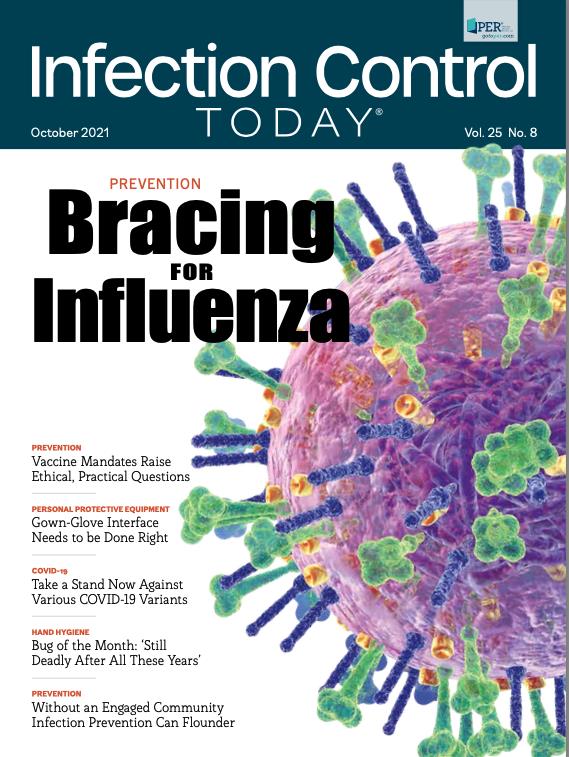COVID Contingency Plan Includes New Type of Mask
An infection prevention officer at the hospital along with key clinical personnel and administrators had to give the OK for the prototype mask to be manufactured.
T
o match steps with crisis is to dance with uncertainty,” say investigators in study findings published in the American Journal of Infection Control.1 “A structure for decision-making and executive sponsorship is necessary to allow available information to be rapidly assembled and then decisively acted upon.”
The decision-making necessary to pull off the manufacturing of a new type of mask with entities that don’t often work together was facilitated by working with an Incident Command Center.
The uncertainty the study authors refer to will be all too familiar to infection preventionists and other health care professionals on the frontlines of the COVID-19 pandemic. It concerns the supply of personal protective equipment (PPE), particularly masks, and especially during early 2020.
Investigators from the University of Colorado School of Medicine and the University of Colorado College of Engineering set out to determine whether it would be best for hospitals and other health care facilities to put their efforts into shoring up existing medical supply lines or inventing alternative methods—and novel mask designs—to meet the need during COVID-19 surges.
“Based on the vital importance of being able to deliver PPE in preserving the health and trust of the medical workforce, our academic medical center elected to pursue this avenue to meet what was potentially going to be an unmet need based on the information available early in the pandemic,” the authors state. “As of this point, these novel masks, and the manufacturing capability to create more, remain in reserve. However, based on our experience, the iterative process from design to production required several months, and subsequent waves of COVID-19 have demonstrated that regional supplies of equipment can be strained long after the initial surge has passed.”
The investigators’ aim, they write, was to “design and manufacture a novel, reusable, half-face respirator in case conventional medical supply chain failed to meet demand.”
However, they had 3 major concerns. The first was to not let the new masks foster a false sense of security among clinicians who would be wearing them. The investigators explained toclinicians just what the new masks could and couldn’t do. Another concern was that clinicians and the public might become anxious knowing that a new mask was being manufactured because supply lines could run dry. The investigators and hospital administrators thus decided to keep the project secret.
The third concern was the question of legal liability if the hospital used masks that had not been approved by the National Institute for Occupational Safety and Health. “To address this, the decision was made that [Jared Polis, governor of Colorado] would need to declare crisis standards of care and the conventional PPE options available to the hospital would have to be exhausted before they would see use,” the authors write.
The investigators wanted to design a mask that afforded the same protection as an N95 respirator. It would need to be able to be decontaminated and reused and be able to fit inside a face shield without causing fogging.
“Via the Incident Command Center, our infection prevention officer reviewed the prototype with key clinical and executive leadership for input and to establish buy-in during the iterative design phase,” the authors note. “The center was also critical in approving simulated fit testing of the novel design through Employee Health.”
The industries needed to help in the manufacturing process were not the type that usually work with health care organizations, according to the investigators. The University of Colorado’s College of Engineering facilitated the manufacturing process.
“An original mask design was developed and the University Hospital had an initial batch of this novel mask manufactured during the first wave of the SARS-CoV-2 pandemic,” the authors write. “These masks, and the die necessary to produce more, [are] in reserve in case of depletion of stores of conventionally sourced PPE.”
The study concludes: “Health care organizations facing similar crisis in the future need to make this decision early. One way or another, by the time the surge peaks, or next pandemic wave arrives, the die is cast.”
SOURCE FOR ILLUSTRATION: Cumbler E, Wittig M, Jacobson N, et al. Contingency planning for healthcare worker masks in case of medical supply chain failure: Lessons learned in novel mask manufacturing from COVID-19 Pandemic. Am J Infect Control. Published online August 4, 2021. Accessed August 7, 2021. doi:https://doi.org/10.1016/j.ajic.2021.07.018
Reference:
- Cumbler E, Wittig M, Jacobson N, et al. Contingency planning for health care worker masks in case of medical supply chain failure: lessons learned in novel mask manufacturing from COVID-19 pandemic. Am J Infect Control. Published online August 4, 2021. doi:10.1016/j.ajic.2021.07.018
